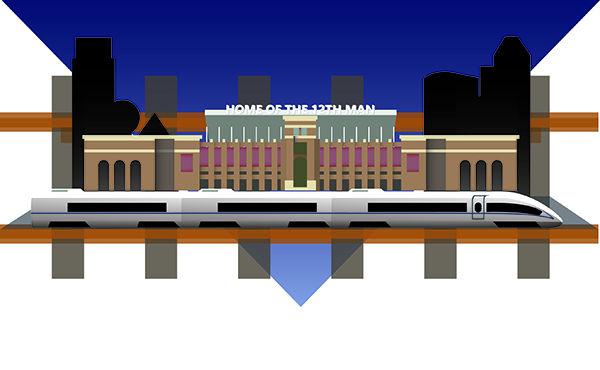Texas may host America’s first high-speed rail line, and the Texas A&M area has risen as a possible stop-over location.
A high-speed rail line proposal between Houston and Dallas has gained momentum as a cheap and quick connection between Texas’ two largest cities. One of the proposed routes places the line’s sole waypoint in Bryan-College Station — a distinction that advocates and local government officials say could spell dividends for the local community, if the line is ultimately built and if residents agree to it.
Mac Boles, Class of 2000 and high-speed rail advocate, said the proposed route would give students and visitors a cheap and fast travel alternative. He said Texas Central Railway and B-CS would especially benefit during football season.
“A usual three-hour trip to College Station for home football games would be cut down travel time to an hour or less,” Boles said. “I could come to a Saturday night game, be back before midnight and not need to spend money on an expensive hotel room. Thousands of potential riders will be traveling from Houston to Dallas to fill up a 100,000 seat venue — that’s some serious ticket sales for the train company.”
Texas Central Railway — the for-profit company behind the proposal — aims to use high-speed trains capable of operating at speeds in excess of 200 miles per hour, moving passengers between Dallas and Houston in less than 90 minutes. The technology has been used to great success in Japan, where high-speed rail connects several important cities.
Boles also said such an accessible route would solidify Texas A&M in the nation’s consciousness.
“This route would provide service from two huge international airports — DFW and George Bush Intercontinental,” Boles said. “Visiting professors, world leaders and prospective students will have unprecedented access to Texas A&M like no other university has in the U.S.”
The B-CS station currently planned would lie approximately 15 miles outside College Station. Rebecca Cowle, Class of 2012 and outreach coordinator for the Texas Central Railway, said this station would provide a safe trip to and from the station for students and others in the community.
“Texas Central Railway has been working with Texas A&M and elected leaders in B-CS for years,” Cowle said. “We have identified some ways to provide a safe alternative mode of travel for students while staying true to our private-led model.”
Allan Rutter, research scientist at the Texas A&M Transportation Institute, said the developers have not finalized a precise station location until a proper cost-benefit analysis has been conducted. A final verdict is still far ahead in the future.
“[Developers] need to decide if putting a station in our area increases their chances to maximize revenue,” Rutter said. “Given this rail project is privately funded, the decision of where stops go and how many there are is a matter of whether it makes financial sense or not.”
In addition to financial matters, developers are paying careful attention to how building a through-route and station would affect people residing on or close to the desired property.
Blanche Brick, College Station City Council mayor pro tem, said while public interest in the high-speed rail is strong, no one wants their land to be taken.
“Not many people are excited at the prospects of a route going through their property,” Brick said. “Everybody recognizes the advantages, and ultimately private investors need to consider the needs of the community and their best interests in location.”
According to information provided by Texas Central Railway, the Federal Railroad Administration and Texas Department of Transportation held in late October and early December a series of 12 public meetings along the Dallas-Houston corridor to solicit initial public feedback. Representatives of TCR attended the meetings in order to hear firsthand the concerns of the public and to answer questions informally.
The Environmental Impact Statement process, led by the Federal Railroad Administration with the help of TxDot, is estimated to be completed in 18 to 24 months.
The Environmental Impact Statement will also help determine the overall cost of the entire project. If all goes to plan, the rail service is expected to begin in 2021.
Proposed high-speed rail could link Dallas, Houston with College Station stop
February 1, 2015

Sydney Farris — THE BATTALION
0
Donate to The Battalion
Your donation will support the student journalists of Texas A&M University - College Station. Your contribution will allow us to purchase equipment and cover our annual website hosting costs.
More to Discover







